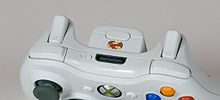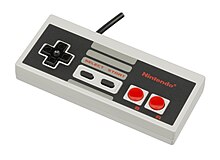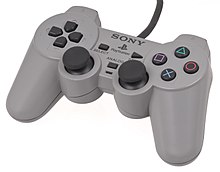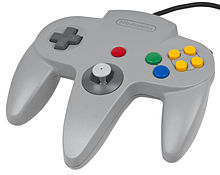This is an old revision of this page, as edited by 98.178.184.196 (talk) at 03:12, 12 December 2021 (→Features). The present address (URL) is a permanent link to this revision, which may differ significantly from the current revision.
Revision as of 03:12, 12 December 2021 by 98.178.184.196 (talk) (→Features)(diff) ← Previous revision | Latest revision (diff) | Newer revision → (diff) Type of video game controller This article is about the type of video game controller. For the TV show, see Gamepad (TV series). For the primary controller for Nintendo's Wii U console, see Wii U GamePad. For the Android device, see Archos GamePad. Not to be confused with Gaming keypad or Joystick.This article has multiple issues. Please help improve it or discuss these issues on the talk page. (Learn how and when to remove these messages)
|

A gamepad is a type of game controller held in two hands, where the fingers (especially thumbs) are used to provide input. They are typically the main input device for video game consoles.
Features

Gamepads generally feature a set of buttons handled with the right thumb and a direction controller handled with the left. The direction controller has traditionally been a four-way digital cross (also named a joypad, or alternatively a D-pad, and never called arrow keys), but most modern controllers additionally (or as a substitute) feature one or more analog sticks.
Some common additions to the standard pad include shoulder buttons (also called "bumpers") and triggers placed along the edges of the pad (shoulder buttons are usually digital, i.e. merely on/off; while triggers are usually analog); centrally placed start, select, and home buttons, and an internal motor to provide force feedback. Analog triggers, like that of the GameCube controller, are pressure-sensitive and games can read in the amount of pressure applied to one to control the intensity of a certain action, such as how forceful water is to be sprayed in Super Mario Sunshine.

There are programmable joysticks that can emulate keyboard input. Generally they have been made to circumvent the lack of joystick support in some computer games, e.g. the Belkin Nostromo SpeedPad n52. There are several programs that emulate keyboard and mouse input with a gamepad such as the free and open-source cross-platform software antimicro, Enjoy2, or proprietary commercial solutions such as JoyToKey, Xpadder, and Pinnacle Game Profiler.
History
Analog joysticks
The 1962 video game Spacewar! initially used toggle switches built into the computer readout display to control the game. These switches were awkward and uncomfortable to use, so Alan Kotok and Bob Saunders built and wired in a detached control device for the game. This device has been called the earliest gamepad.
Entry into the mass market

Continued refinements

The original Sega Genesis/Mega Drive control pad has three face buttons, but a six-button pad was later released. The SNES controller also featured six action buttons, with four face buttons arranged in a diamond formation, and two shoulder buttons positioned to be used with the index fingers, a design which has been imitated by most controllers since. The inclusion of six action buttons was influenced by the popularity of the Street Fighter arcade series, which utilized six buttons.


For most of the 1980s and early 1990s, analog joysticks were the predominant form of gaming controller for PCs, while console gaming controllers were mostly digital. This changed in 1996 when all three major consoles introduced an optional analog control. The Sony Dual Analog Controller had twin convex analog thumbsticks, the Sega Saturn 3D Control Pad had a single analog thumbstick, and the Nintendo 64 controller combined digital and analog controllers in a single body, starting a trend to have both an analog stick and a d-pad.
Despite these changes, gamepads essentially continued to follow the template set by the NES controller (a horizontally-oriented controller with two or more action buttons positioned for use with the right thumb, and a directional pad positioned for use with the left thumb).
Gamepads failed to achieve any sort of dominance outside of the home console market, though several PC gamepads have enjoyed popularity, such as the Gravis PC GamePad.
Three-dimensional control
Uses
Gamepads are also available for personal computers. Examples of PC gamepads include the Asus Eee Stick, the Gravis PC, the Microsoft SideWinder and Saitek Cyborg range, and the Steam Controller. Third-party USB adapters and software cB additionally usable on DualShock 3 and DualShock 4. Xbox 360 and Xbox One controllers are officially supported on Windows with Microsoft-supplied drivers; a dongle can be used to connect them wirelessly, or the controller can be connected directly to the computer over USB (wired versions of Xbox 360 controllers were marketed by Microsoft as PC gamepads, while the Xbox One controller can be connected to a PC via its Micro USB slot).
See also
References
- Schaaf, Tobiasa, "Gamestation Turbo" (PDF), ODROID Magazine, no. July 2014, p. 17
- Ryochan7. "Graphical program used to map keyboard keys and mouse controls to a gamepad". Retrieved July 6, 2016.
{{cite web}}: CS1 maint: numeric names: authors list (link) - Yifeng Huang (May 6, 2013), Enjoy2 v1.2 released: control games with your gamepad on OSX, retrieved May 19, 2017
- ^ "Get a Grip!!!: Joysticks Past, Present & Future" (PDF). Next Generation. No. 17. Imagine Media. May 1996. pp. 34–42. Retrieved November 20, 2019.
- "face buttons". Gematsu. sal romano. Retrieved 26 August 2010.
- "6 Button Controller". segagagadomain.com. Archived from the original on March 3, 2016. Retrieved 1 August 2010.
- Ashcraft, Brian (2008). Arcade Mania!: The Turbo-Charged World of Japan's Game Centers. Kodansha. p. 192. ISBN 978-4-7700-3078-8.
- Jamin Brophy-Warren, Magic Wand: How Hackers Make Use Of Their Wii-motes, Wall Street Journal, April 28, 2007
- Hanson, Matt. "How to use the PS4 DualShock 4 controller on a PC". Techradar. Archived from the original on January 19, 2016. Retrieved 4 June 2016.
- Plunkett, Luke (July 23, 2013). "How To Use A Console Controller On Your PC". Kotaku. Retrieved 4 June 2016.
| Video game controllers | |||||
|---|---|---|---|---|---|
| Controller types | |||||
| Controller parts |
| ||||
| Related | |||||